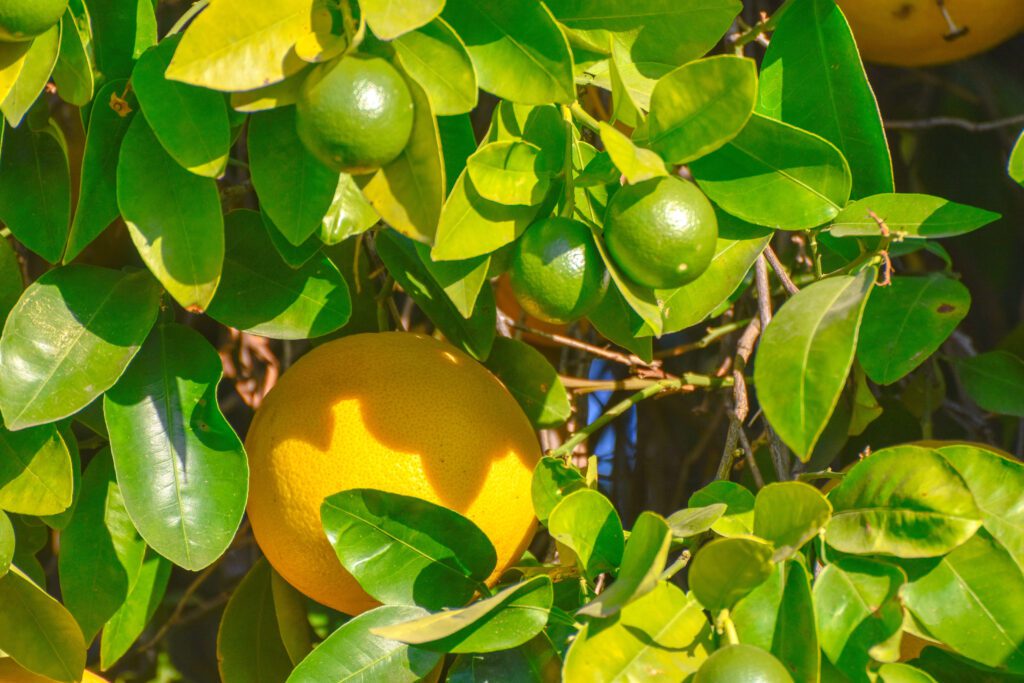by RYAN MILEJCZAK
Sponsored by Farm Credit of Central Florida
Oranges might be the star when it comes to Florida citrus, but their cousin the grapefruit is well deserving of the spotlight as well.
The grapefruit, Citrus x paradisi, is a hybrid fruit that was first found in Barbados in the 18th century. It resulted from the accidental hybridization of the sweet orange (Citrus x sinensis) and the pomelo (Citrus maxima), and in modern times, comes in both white and red varieties. It was originally referred to as the “forbidden fruit,” and it wasn’t until the early 19th century that the name grapefruit first appeared.
There are two main theories about the peculiar name of this fruit, which has no relation to grapes. The first theory is that the fruit was named for a supposed similarity in flavor to grapes, likely a sour variety rather than sweet table grape. The other, more likely theory is that the grapefruit takes its name from the way fruit sometimes grows in clusters on the tree, resembling a bunch of grapes.
The grapefruit first found its way to Florida in 1823, when Count Odet Philippe brought them to Safety Harbor. As the Florida citrus industry entered full swing in the 1900s, grapefruit became one of the most planted crops in the state, along with other citrus varieties. In 1910, the pink grapefruit was first discovered by Kimball Chase Atwood when one of his trees started producing pink fruit, and quickly became the most popular variety of grapefruit.
Like most citrus fruit, grapefruit is an excellent source of Vitamin C. It also provides good amounts of potassium, thiamine, and folate. Plus, it’s a healthy snack that’s very low in carbs. Perhaps due to this, the grapefruit was central to a fad diet that first emerged in the 1930s, called the grapefruit diet, Hollywood diet, or 18-day diet. While this diet isn’t as popular today, it’s likely part of why a grapefruit with sugar sprinkled over top remains a popular breakfast choice.
One of grapefruit’s most interesting properties is its ability to interact with numerous drugs. This is due to substances such as furanocoumarins, which inhibit enzymes in the liver that metabolize many common medications. This keeps medications from being absorbed properly, possibly causing side effects. This can happen with a wide variety of medications, including common drugs like Zoloft and Adderall.
Today, Florida is the second-largest producer of grapefruit in the U.S., second only to California. Florida grapefruit are in season from October to June. Currently, there are 14,316 acres of Grapefruit grown in Florida.
In the 2023-2024 season, Florida produced 1.79 million boxes of grapefruit, down slightly from the previous year’s 1.81 million boxes, with the majority — 1.6 million boxes — being red, compared with only 240,000 boxes of white grapefruit.
Grapefruit are just one part of the state’s citrus industry, which has been mired by greening and canker. According to the Florida Department of Citrus, the industry employs more than 33,000 people, provides an annual economic impact of $6.762 billion to the state, and contributes hundreds of millions of dollars in tax revenues.
As the industry continues to fight greening and increased development, scientists and growers are working hard to come up with solutions, whether in the form of antimicrobial peptides, oxytetracycline, or individual protective covers (IPCs).

